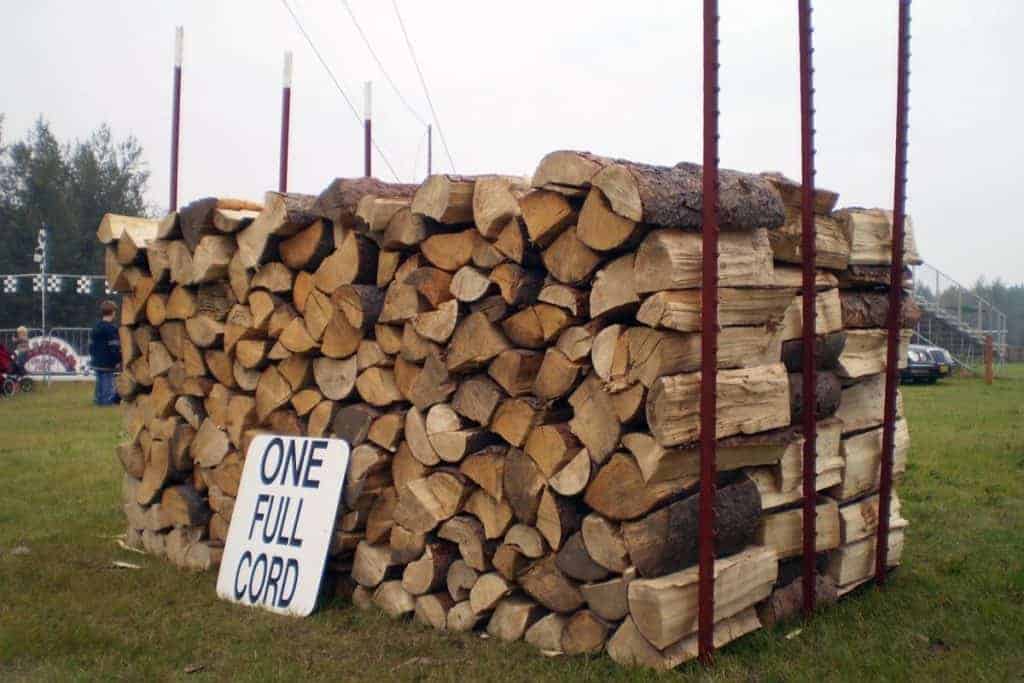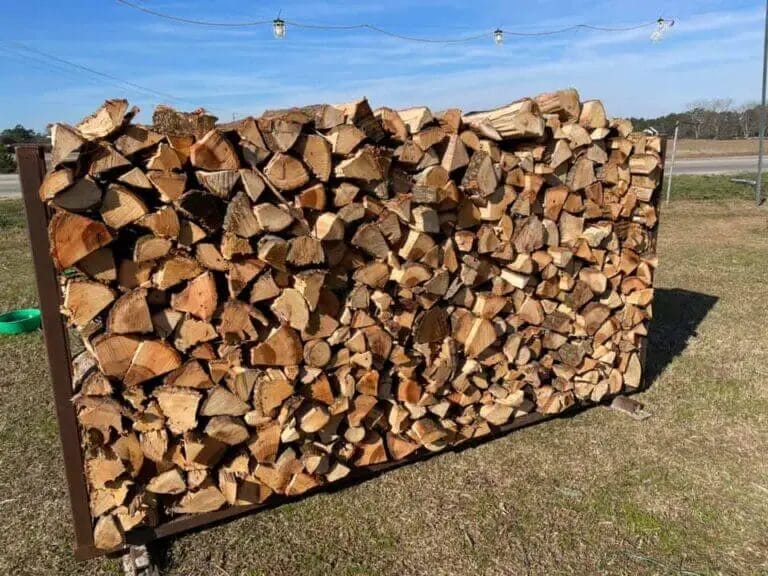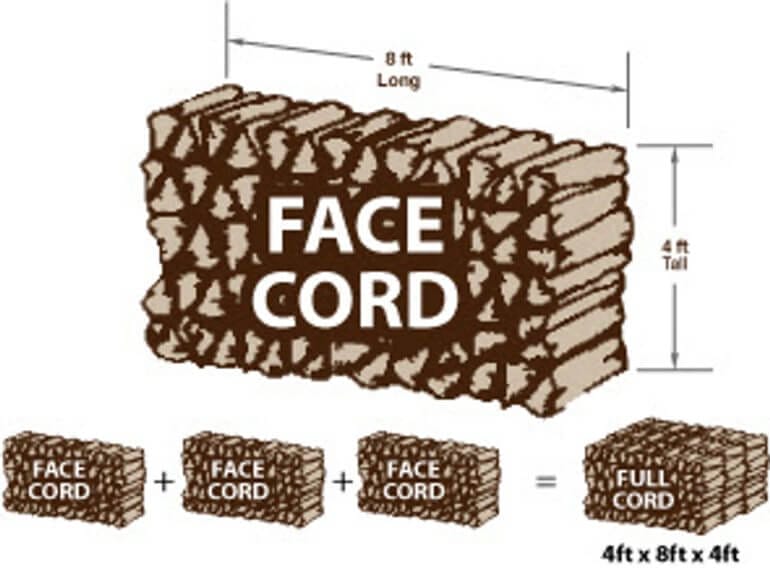A face cord of wood is a popular measurement used to determine the quantity of firewood. Although the weight of a face cord can vary depending on the type of wood, it typically weighs between 1,500 and 2,000 pounds. This measurement is commonly used to estimate the amount of wood needed for heating purposes, such as in fireplaces or wood-burning stoves. Understanding the weight of a face cord can help homeowners accurately plan and budget for their firewood needs.


Common Wood Types and their Weight in a Face Cord
When it comes to burning firewood, one important factor to consider is the weight of the wood. The weight can determine how much heat the wood will produce and how long it will burn. A face cord is a measurement of wood that is commonly used in the firewood industry. It is a stack of wood that is 4 feet high, 8 feet long, and the depth of the wood varies.

There are several common wood types that are used for firewood, each with their own characteristics and weight. Let’s take a look at some of the most popular wood types and their weight in a face cord:
Oak
Oak is one of the most popular wood types for firewood due to its high heat output and long burn time. It is a dense hardwood that can provide a steady and consistent heat. In a face cord, oak wood can weigh between 2,500 and 4,000 pounds.
Maple
Maple wood is another excellent choice for firewood. It burns well and produces a moderate heat output. In a face cord, maple wood can weigh between 1,800 and 2,800 pounds.
Birch
Birch wood is known for its beautiful bark and bright flames. It burns quickly but can provide a good amount of heat. In a face cord, birch wood can weigh between 1,800 and 2,600 pounds.
Ash
Ash wood is a popular choice for firewood as it burns well and produces a good amount of heat. It is not as dense as some other hardwoods, but still provides a reliable source of heat. In a face cord, ash wood can weigh between 2,000 and 3,000 pounds.
Pine
Pine wood is a softwood that is commonly used for firewood due to its affordability and fast burn time. It produces a pleasant aroma when burned. In a face cord, pine wood can weigh between 1,200 and 1,800 pounds.
It’s important to note that the weight of wood can vary depending on its moisture content. Green or freshly cut wood will weigh more compared to seasoned or dry wood. Seasoning wood involves allowing it to dry out for a certain period of time, typically 6 to 12 months, to reduce its moisture content.
In summary, the weight of wood in a face cord can vary depending on the wood type and its moisture content. Oak tends to be the heaviest, while pine is the lightest. Understanding the weight of different wood types can help you make an informed decision when selecting firewood for your needs.

The Importance of Properly Measuring and Stacking a Face Cord
When it comes to purchasing firewood, it is essential to understand the measurements and stacking techniques in order to get the most value for your money. One common measurement used in the firewood industry is the face cord. In this section, we will discuss the importance of properly measuring and stacking a face cord of firewood.
Understanding the Face Cord Measurement
A face cord is a unit of measurement used to quantify firewood. It is defined as a stack of wood that is 4 feet high, 8 feet long, and as wide as the depth of the individual logs. However, it is important to note that the depth of the logs may vary, typically ranging from 12 to 24 inches.
By understanding the dimensions of a face cord, you can ensure that you are receiving the amount of firewood you paid for. This is especially important when purchasing firewood in bulk or from a supplier who sells by the face cord.
Accurate Measurement for Fair Pricing
Properly measuring a face cord is crucial for fair pricing. When purchasing firewood, you want to make sure you are getting what you pay for. By accurately measuring the stack of wood, you can ensure that you are not being overcharged or shortchanged.
When measuring a face cord, start by measuring the height of the stack, ensuring it is 4 feet tall. Then, measure the length of the stack, making sure it is 8 feet long. Finally, measure the depth or width of the stack, taking into account the size of the logs. By following these measurements, you can accurately determine the amount of firewood in a face cord and negotiate a fair price.
Efficient Stacking for Better Firewood Quality
In addition to accurate measurement, proper stacking techniques are important for maintaining the quality of firewood. When stacking a face cord, it is essential to stack the wood in a neat and organized manner. This allows for better airflow and drying, ensuring that the firewood burns efficiently.
One recommended stacking method is the “crosshatch” or “crisscross” pattern. This involves alternating the direction of the logs in each layer, creating a stable and well-ventilated stack. Additionally, it is important to stack the logs tightly together, minimizing any gaps or spaces that could lead to uneven drying or potential rot.
In summary, properly measuring and stacking a face cord of firewood is of utmost importance. Accurate measurement ensures fair pricing and prevents any discrepancies in the quantity of firewood received. Efficient stacking techniques promote better firewood quality, allowing for optimal drying and efficient burning. By understanding the measurements and employing proper stacking methods, you can maximize the value and enjoyment of your firewood purchase.
Tips for Buying and Storing Face Cords of Wood
When it comes to buying firewood for your fireplace, wood stove, or outdoor fire pit, it’s important to know what to look for and how to properly store it. Face cords of wood are a popular option for many homeowners, as they provide a convenient and cost-effective way to heat your home during the colder months. In this section, we will discuss some helpful tips for buying and storing face cords of wood.
1. Determine the Amount of Wood You Need
Before purchasing a face cord of wood, it’s important to determine how much wood you will need for your heating needs. Consider factors such as the size of your fireplace or wood stove, and how often you plan on using it. A face cord typically consists of a stack of wood that measures 4 feet high, 8 feet wide, and 16 inches deep, which is equivalent to one-third of a full cord of wood.
2. Choose the Right Type of Wood
Not all types of wood are created equal when it comes to burning efficiency and heat output. Hardwoods such as oak, maple, and hickory are known for their high energy content and long burn times. Softwoods like pine and spruce, on the other hand, may burn faster but produce less heat. Consider your specific heating needs and the availability of different types of wood in your area before making a decision.
3. Inspect the Wood for Quality
When purchasing a face cord of wood, take the time to inspect its quality. Look for wood that is dry, seasoned, and free from signs of rot or insect infestation. Dry wood will burn more efficiently and produce less smoke. Avoid wood that feels excessively wet or has a strong odor, as these are signs of high moisture content.
4. Ask About the Age and Storage Conditions
It’s important to inquire about the age and storage conditions of the wood you are purchasing. Ideally, the wood should be seasoned for at least 6-12 months to ensure optimal moisture content. Ask the seller about where and how the wood has been stored, as wood that has been properly stored in a dry and well-ventilated area will have a lower moisture content and burn more efficiently.
5. Properly Store the Wood
Once you have purchased your face cord of wood, it’s crucial to store it properly to maintain its quality and burn efficiency. Choose a location away from the ground and protected from rain and snow. Use a firewood rack or stack the wood on pallets to allow for proper airflow and prevent moisture buildup. Cover the top of the stack with a tarp or firewood cover to protect it from the elements.
In summary, buying and storing face cords of wood requires careful consideration and attention to detail. By following these tips, you can ensure that you are purchasing high-quality wood and storing it in a way that maximizes its burn efficiency and longevity. Stay warm and cozy throughout the winter season with well-maintained firewood!
FAQs
How much does a face cord of wood weigh?
The weight of a face cord of wood can vary depending on the type of wood and its moisture content. On average, a face cord of seasoned hardwood weighs approximately 3,000 to 4,000 pounds.
How long is a face cord of wood?
A face cord of wood typically measures 8 feet long. The height and width vary based on how the wood is stacked, but it is generally 4 feet high and 16 inches wide.
How much wood is in a face cord?
A face cord of wood contains approximately one-third of a full cord. It typically consists of a stack of split firewood measuring 8 feet in length, 4 feet in height, and 16 inches in width.
Conclusion
In conclusion, the weight of a face cord of wood varies depending on the type of wood and its moisture content. On average, a face cord of seasoned hardwood weighs between 2,500 to 3,000 pounds, while a face cord of green or freshly cut wood can weigh up to 4,000 pounds or more. It is crucial to consider the weight when purchasing firewood, as it affects transportation, storage, and usability. Remember to consult with your local supplier for accurate weight estimations and ensure you have the appropriate tools and equipment to handle the weight of the wood.
Having a reliable estimate of the weight of a face cord of wood allows you to plan and make informed decisions when it comes to purchasing and using firewood. Understanding the weight will help you determine the number of face cords you need, the strength required to handle them, and the capacity of your storage area. Additionally, it is vital to factor in the weight when considering the transportation logistics and any potential restrictions that may come with it. By knowing the weight, you can ensure a safe and efficient firewood experience.
